
Fiji is a group of volcanic islands in the South Pacific, lying about 4,450 kilometres (2,765 mi) southwest of Honolulu and 1,770 km (1,100 mi) north of New Zealand. Of the 332 islands and 522 smaller islets making up the archipelago, about 106 are permanently inhabited. The total land size is 18,272 km2 (7,055 sq mi). It has the 26th largest Exclusive Economic Zone of 1,282,978 km2 (495,361 sq mi).

Fantails are small insectivorous songbirds of the genus Rhipidura in the family Rhipiduridae, native to Australasia, Southeast Asia and the Indian subcontinent. Most of the species are about 15 to 18 cm long, specialist aerial feeders, and named as "fantails", but the Australian willie wagtail is a little larger, and, though still an expert hunter of insects on the wing, concentrates equally on terrestrial prey.

Woodswallows are soft-plumaged, somber-coloured passerine birds in the genus Artamus. The woodswallows are either treated as a subfamily, Artaminae, in an expanded family Artamidae, or as the only genus in that family. The generic name, which in turn gives rise to the family name, is derived from the Ancient Greek artamos, meaning butcher or murder. The name was given due to their perceived similarity to shrikes. A former common name for the group was "swallow-starlings".

The white-breasted woodswallow is a medium-sized passerine bird which breeds from the Andaman Islands east through Indonesia and northern Australia. The name "woodswallow" is a misnomer as they are not closely related to true swallows. Instead, they belong to the family Artamidae, which also includes butcherbirds, currawongs and the Australian magpie.
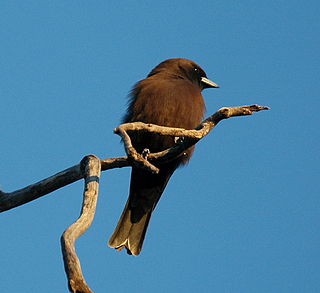
The little woodswallow, is a bird patchily distributed over much of mainland Australia, avoiding only the driest deserts and the area within about 300 kilometres of the southern coastline, and showing a preference for rugged terrain around inland ranges.

The black-faced woodswallow is a woodswallow of the genus Artamus native to Australia, New Guinea and the Sunda Islands, including Timor. It is 18–19 cm (7.1–7.5 in) long and is the most widespread species in the family Artamidae. Woodswallows have a soft call with chiff, chap and chattering calls which can include vocal mimicry
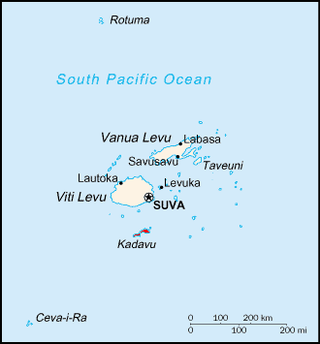
Kadavu, with an area of 411 square kilometres (159 sq mi), is the fourth largest island in Fiji, and the largest island in the Kadavu Group, a volcanic archipelago consisting of Kadavu, Ono, Galoa and a number of smaller islands in the Great Astrolabe Reef. Its main administrative centre is Vunisea, which has an airport, a high school, a hospital, and a government station, on the Namalata Isthmus where the island is almost cut in two. Suva, Fiji's capital, lies 88 kilometres to the north of Kadavu. The population of the island province was 10,167 at the most recent census in 2007.

The ashy woodswallow, sometimes also called the ashy swallow-shrike, is a woodswallow which is found in south Asia. Like other woodswallows, it has a short curved bill, a short square tail and long wings. It is usually seen perched in groups, high on powerlines, tall bare trees and most often in areas with a predominance of tall palm trees.

The crimson shining parrot is a parrot from Fiji. The species is endemic to the islands of Kadavu and Ono in the Kadavu Group. The species was once considered conspecific with the red shining parrot of Vanua Levu and Taveuni, but is now considered its own species. The species is sometimes known as the Kadavu musk parrot.

The Fiji parrotfinch is a species of estrildid finch endemic to Fiji that was formerly considered to be a subspecies of the red-headed parrotfinch. This parrotfinch is a small, mainly green bird with a red head and tail and a stubby dark grey bill. It is found in both forested and open habitats, and has adapted well to man-made environments such as grasslands, pasture and gardens. Pairs have a courtship display in which they fly above the trees in an undulating flight, calling constantly. Breeding birds build a domed grass nest with a side entrance, and lay a clutch normally of four white eggs. Newly hatched chicks are naked and pink, with blue balls at the upper and lower corners of the gape, and black markings inside the mouth; older fledglings resemble the adults, but lack the red head colouring. The Fiji parrotfinch eats seeds, especially of grasses, and also readily feeds on insects and nectar. It forms small flocks of up to six birds after the breeding season.

The dusky woodswallow is a bird species of forests and woodlands in temperate and subtropical regions, extending into tropical areas around the Atherton Tableland, in eastern and southern Australia. The global population of the species has as yet not been formally confirmed, but it has been officially rated in the range of 'Least Concern', according to the BirdLife International in 2004. As such, the bird could be described as common in its local habitat.
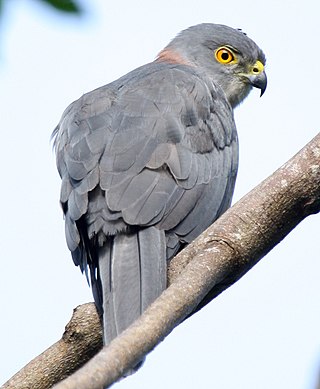
The Fiji goshawk is a species of bird of prey in the family Accipitridae. It was once considered to be the same species (conspecific) as the brown goshawk of Australia and New Caledonia. It is endemic to Fiji, where it occurs on the larger islands of Viti Levu, Vanua Levu, Taveuni, Kadavu, Gau and Ovalau. It occupies a range of wooded habitats in Fiji, from natural rainforest to coconut plantations and urban gardens and parks.

The maroon shining parrot or red shining-parrot, is a species of parrot in the family Psittaculidae. It is native to the islands of Vanua Levu and Taveuni in Fiji and was introduced to the islands of southern Tonga in prehistoric times. The species is sometimes considered conspecific with the crimson shining-parrot of Kadavu. Its natural habitats are subtropical or tropical moist lowland forests and subtropical or tropical mangrove forests.

The great woodswallow, also known as the greater woodswallow, giant woodswallow or New Guinea woodswallow is a species of bird in the family Artamidae. As its name implies, it is the largest member of the genus Artamus, averaging 20 centimetres (7.87 in) in length and 61 grams (2.2 oz) in mass. In appearance the great woodswallow is very similar to the more widespread white-breasted woodswallow but can be distinguished by its darker black upper side plumage and by the presence of a semi-oval black patch below the throat.

The Polynesian triller is a passerine bird belonging to the triller genus Lalage in the cuckoo-shrike family Campephagidae. It has numerous subspecies distributed across the islands of the south-west Pacific.

The Fiji white-eye is a species of passerine bird in the white-eye family Zosteropidae. The species is also known as Layard's white-eye.

Artamidae is a family of passerine birds found in Australia, the Indo-Pacific region, and Southern Asia. It includes 24 extant species in six genera and three subfamilies: Peltopsinae, Artaminae and Cracticinae. Artamids used to be monotypic, containing only the woodswallows, but it was expanded to include the family Cracticidae in 1994. Some authors, however, still treat the two as separate families. Some species in this family are known for their beautiful song. Their feeding habits vary from nectar sucking (woodswallows) to predation on small birds.
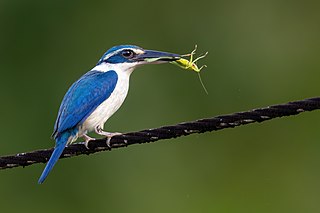
The Pacific kingfisher is a medium-sized kingfisher belonging to the subfamily Halcyoninae, the tree kingfishers. It has a wide range throughout the South Pacific islands. It was previously considered a subspecies of the collared kingfisher.

Severe Tropical Cyclone Ana was one of three tropical cyclones to impact the island nation of Fiji towards the end of January 2021. The fifth tropical disturbance, third tropical cyclone and second severe tropical cyclone of the 2020–21 South Pacific cyclone season, Ana was first noted as Tropical Disturbance 05F during January 26, while it was located about 220 km (135 mi) to the northeast of Port Vila in Vanuatu. Over the next few days, the system moved eastwards and gradually developed further, before it was declared to be a tropical cyclone and named Ana during January 29. Over the next day, the system moved south-eastwards towards Fiji before it made landfall on the island of Viti Levu. After emerging into the Pacific Ocean, the system intensified into a Category 3 severe tropical cyclone, before it rapidly degenerated into a subtropical low during February 1.
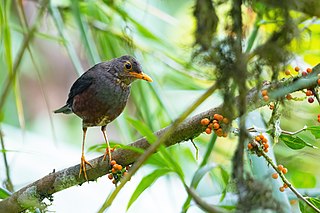
Fiji island-thrush is a species of passerine in the thrush family Turdidae that is endemic to Fiji. It was formerly considered a subspecies of island thrush, but in 2024 the island thrush was split into 17 separate species by the IOC and Clements Checklist based on morphological and phylogenetics differences.





















